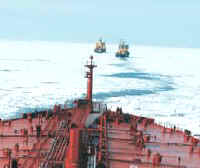
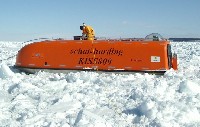
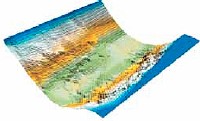
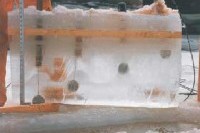
Ice Gouging Analyses for Sakhalin Pipeline
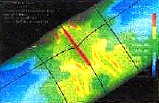
Ice gouge depth measurements were evaluated for specific return periods and water depths along the pipeline. Limited gouge depths were evaluated based on the interrelationship between the soil strength and the expected ice keel strengths. In addition, probabilistic analyses were carried out taking into account the local topography and bathymetry, the expected ice drift directions, ice incursion frequencies, ice draft distributions and the ridge keel spacings. The results were used as important input to the selection of design ice gouge depths used to determine burial depths of the pipeline.
Environmental Data Collection in the Caspian Sea
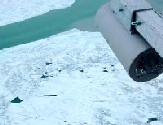
BMT performed data collection in the Caspian sea as part of an Ice Field Program for an oil company. Data was collected using an airborne system to measure ice thickness, using ground penetrating radar. Laser scanning technology was applied to map the surface topography of ice rubble piles at drilling structures and stamukha. The data has been analyzed to develop statistics as input into the design process.
Ice Loads on Hydroelectric Dams
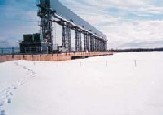
On behalf of Canadian Electricity Association Technologies, Ontario Hydro, Hydro Quebec and Manitoba Hydro, BMT developed a computer based Ice Load Design Guide to predict ice loads on hydroelectric dams for station sin Quebec, Ontario and Manitoba. The program predicts ice loads for various return periods and operating regimes. The eleven year project improved the existing ice load design criteria for dams and included nine years of field measurements.
Web Based Surveillance for Remote Site Monitoring

BMT has installed a network of web based surveillance cameras which are used for monitoring ice. The web surveillance cameras provided a valuable added feature in the deployment and monitoring of ice booms. Telesat web access via satellite enabled users to remotely monitor ice formation and break-up as well as boom performance over the winter months, via any internet connection. With pan, tilt and zoom features controlled by the users' PC, the cameras provided the capture of images in real time in order to monitor river conditions, perform visual maintenance inspections and assess personnel safety.
Friction on Airport Runways In Wintertime
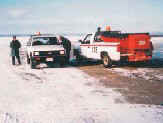
On behalf of Transport Canada, BMT conducted field tests to compare results generated by various friction testing systems at various airports in northern Ontario. The tests were also performed to evaluate the effect of having the vehicles anti-lock braking systems on versus off. The results were analyzed in relation to their effect on required landing distances.
Pipelines Under Ice Covered Waters

BMT performed work contributing to the development of recommendations for pipeline burial depths for a BP pipeline. The work made use of statistical analyses, deterministic analyses of physical limits imposed by ice strength and structural analyses of pipeline behaviour during gouging events and saw BMT's arctic and pipeline integrity expertise working together.
Ice Transiting Analyses in the St. Lawrence System
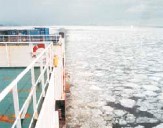
BMT made observations and recorded video data aboard the MV Cicero on several voyages. The transiting performance of the ship in open water and ice conditions was analyzed to contribute to an overall effort by the Ice and Marine Services of Environment Canada and Canadian Coast Guard to develop improved capabilities for route forecasting.
Selected Boom Projects
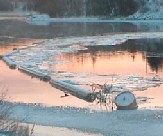
BMT has completed a number of boom projects in the past five years, including:
-
development of a method to submerge and re-float an ice boom
-
boom design for peat moss intake reduction
-
boom development for oil spills in ice infested waters
-
boom design for various sites include site assessment, boom design or recommendation and/or fabrication and installation
Measurement of Ice Forces on Hydraulic Structures
Loads on dam structures due to thermal expansion and water level changes was measured. Hundreds of ice pressure sensors were deployed. A design criteria for ice loads on Dams was developed. The work was done at four sites in the Ottawa area, three dams and a large open water tank.
The work consisted of measuring the ice forces on two spans of the Lake Erie Ice Boom. Data acquisition systems were installed and several tension links were attached to the boom cables. The loads were collected for winter 1993/94 and analyzed together with data from the St. Lawrence River ice booms.
Numerical Modelling of Ice Loads
Development of a numerical model to predict dynamic ice loads on Arctic offshore structures. A two year project that involved two phases; proposed approach and development of the model.
Monitor effects of ship traffic on the forces on the dock walls in Thunder Bay harbour. Pressure sensors were placed at several locations along the wall and data collected during the ship entrance into the slip. Two icebreakers were used during the tests, a conventional and an icebreaking air cushion bow.
An instrumentation development program was carried out to measure ice forces on offshore structures in the Beaufort Sea. This included concept development, design, manufacturing & testing of several types of sensors to measure a range of pressures between 50 & 5000 kPa.
Filed Surveys were conducted to monitor ice rubble morphology and properties at Tarsiut man made island. The study was carried out to establish the force transferred from the surrounding ice onto the structure.
Design, installation, calibration and commissioning of monitoring system for ice loads on the Molikpaq structure.
Large Scale Arctic Pack Ice Stresses and Forces
Field Measurements were made of pack ice stresses in the southern Beaufort Sea (3 projects) and the data analyzed to predict large-scale pack ice forces.
Pack Ice Pressure Modelling
A two-dimensional model was developed and executed to compares to pressures measured in the field. The prediction of pressure and its rate of increase, the pack ice thickening and the overall ice telescoping expected were made. The results of the predicted pressure are found to be within reasonable agreement with the observed field events.
Pack ice Pressure Loads In the Beaufort Sea
A model for pack ice forces on an offshore structure in southern Beaufort Sea was developed. Two numerical analyses, one using smooth particle hydrodynamics and another using discrete elements, were conducted for pack ice. The two cases where limit-force will provide load relief at the 10-4 annual probability exceedance were analyzed.
Analysis was done of the risk of damage to offshore subsea pipelines due to ice scour and of the subscour stresses exerted on a pipeline during scouring events.
The significance of sea ice as a scouring agent along the Beaufort sea shoreline in the Beaufort Sea was evaluated by reviewing the available field data and by conducting numerical analyses. Ice features and their potential scouring magnitude were studied.
Review of deterministic models to predict seabed ice scour.
Mapped seabed scours for an Alaskan Beaufort Sea grid using FTL's Imaging Mapping and Profiling Sonar System (IMAPS).
Design, fabrication and installation of an ice boom to reduce the cost of ice clearing operations related to flooding.
Design, fabrication and installation of an ice boom for the Chute Bell hydroelectric power plant.
An ice boom was deployed to hold the ice upstream of Hydro-Quebec and E.B. Eddy hydroelectric power plant water intakes. The boom is located on the Ottawa River, in Hull. The boom was designed, fabricated and installed in November 1997. The project includes monitoring the performance of the ice boom and its effect on improving power production during the winter of 1997/98.
The work consists of analyzing the ice force data from the Lake Erie ice boom and Lavaltrie, Lanoraie and Yamachiche ice boom, all three in the St. Lawrence River. A design was recommended and approved. Five new spans (25% of the boom) were constructed and deployed during the winter of 1996/97. The success of the prototype tests resulted in the replacement of the remaining timber pontoons with steel pontoons for the winter of 1997/98.
The work consisted of measuring the ice forces on two spans of the Lake Erie Ice Boom. Data acquisition systems were installed and several tension links were attached to the boom cables. The loads were collected for winter 1993/94 and analyzed together with data from the St. Lawrence River ice booms.
The work included a review of the past performance of the boom and analyze events where the ice passed over the boom. New design was recommended to improve the ice retention capacity of boom. The boom was deployed for the first time in November 1993.
The work included a review of the past twenty years of operation of the boom (since 1964) and analyze each of the forty events where ice moved over the boom and into the Upper Niagara river. The project is to provide recommendations for alternatives solution to improve the reliability if the boom in retaining ice.
Field observations of the performance of an ice boom deployed in the Copeland Cut of the St. Lawrence River and field measurements of ship induced ice forces transmitted to the boom during passage.
FTL reviewed the past performance of several artificial island built in Lac St. Pierre for Ice Management to guarantee year round ship navigation through the lake. The design criteria were evaluated and recommendations made.
Monitor effects of air bubbler system in melting the ice cover. Temperature arrays were placed at ten strategic locations and data was collected over the ten day period of the experiment.
A continuing program which started in 1980 to investigate ice management methods to guarantee early opening of the harbour. Assessment of various methods and full scale evaluation of these methods is underway.
Design and development of a test apparatus for measuring the abrasion of steel coating by ice. A test machine was built and a three month long cold room tests were carried out.
Design and development of a test standard for concrete abrasion by ice. A prototype test machine was built by FTL and cold room tests were carried out.
Laboratory Testing to Evaluate the Ice Abrasion Resistance of Four Candidate Hardwoods for Fishing Boat Hulls
The tests were conducted over a two-week period during Feb 1998 at North Bay, ON.
Thermally-Modified Sand is a process developed to reduce or eliminate the need for salt to prevent sand stockpiles from freezing.
Tests were carried out over a range of air temperatures on packed snow and bare ice using five sand types applied at different rates. Tests with pre-wetted sand were included in the program.
Field tests at NASA's Wallops Island Facility of tire friction when Type II de-icing fluid is present on various substrates.
Field Measurements of the Ice-Ice and Ice-Snow Friction Factor at Tarsuit, a Beaufort Sea Drilling Platform
Measurement of the Ice-Hull and Snow-Hull Friction Factor for Icebreaking Ships
FTL developed an apparatus for field use and has used it to collect data on four icebreaker trials.
Tests were carried out on asphalt, concrete, ice and smooth surfaces coated with water, and in freezing rain using four different airport runway de-icing chemicals, two different aircraft de-icing chemicals and 24 different sands. A total of 1500 tests were included in the program. The tests were carried out in FTL's refrigerated chamber on surfaces that were 12.8m long.
Evaluation of Snow Friction on LRT Rails
A field observation study was carried out to evaluate methods to mitigate the problem of ice at Hull 2 power plant. A time lapse camera was installed and frequent visits made. The project proposed an ice boom to be placed about 300 m upstream of the intake.
A two phase study was proposed. The first phase consisted of a review of the procedures followed by FTL for solving a potential frazil blockage that may occur at the Nuclear power plant "de Blayais" near Bordeaux France. The work described the procedures to be followed to minimize the consequences of an ice blockage events without significant power loss and other losses. A second Phase is planned for 1997.
This Study evaluated the potential for ice induced blockage at the J.A.F. nuclear power plant and assessed weather the required minimum flow of the plant could be maintained in the presence of ice jams at the water intake trashrack in Lake Ontario.
An engineering study was carried out on an offshore water intake at Pt. Aconi, Nova Scotia that will be subjected to ice ridges and possible blockage of ice. The work included filed surveys, model test in ice and open water and numerical analyses. A concept design was developed to operate in the presence of ice block accumulations.
A review of the operational performance of a water intake at Esso Sarnia Plant was made following blockage by debris and frazil ice. A structural modification was necessary to change the direction of incoming water and to minimize the risk of debris and frazil intrusion.
Model Tests were conducted to locate a water intake to minimize frazil ice ingestion, sedimentation around the intake, and disruption of the prevailing coastal environment. Environmental concerns included local shoreline erosion resulting from changes in the wave field. A second test program was conducted to evaluate operational procedures for the intake.
Six alternatives for an oil spill protection system for the protection of the Jubail water intake from oil spills was developed. The protection systems consisted of a permanent fixed structure, permanent double booms and deployable double booms. These same alternatives were designed for deployment inside and outside the breakwater.
Developed a concept for oil spill barriers to be installed at the Ras Tannura water intake for the protection from oil spill. Provided a concept design for a warning and activation system that monitor in real time the presence of oil in water at the Ras Tannura water intake.
Development of concept designs for sixty water intakes in Saudi Arabia for the protection of sea water intakes from Oil spills. FTL was tasked in carrying out 15 of these intake designs. Oil spill expertise was also part of FTL task. The project included site visit, current distribution, erosion and sedimentation, headloss due to the new oil spill barrier and its effect on the hydraulic regime.